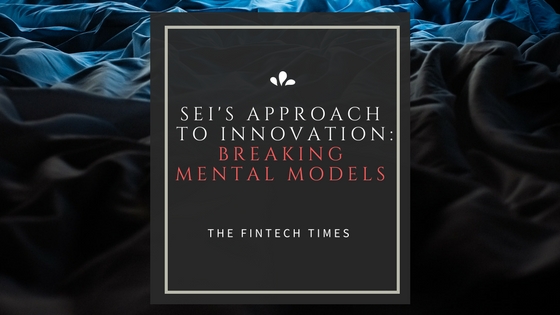We sat down with Russ Kliman, Global Head of Innovation & Strategic Programs for SEI, and chatted all things innovation, fintech and the latest disruptors in the ever-changing industry.
First, tell us a little bit about your current role – working alongside some of the fintech’s leading innovators.
RK: In my role, my focus is to look beyond our current product roadmaps, beyond the 18-month timeframe, and over the horizon to see what’s next. To really place a focus on the next disruptor, the next key in influencer in the wealth management and financial services space. To achieve this, it can’t be done in a vacuum, and as such, I work closely with each business unit across SEI to see what their opportunities are, what problems they’re trying to solve, and what they’re hearing from the pulse of the marketplace. At the same time, we’re monitoring the market, engaging with fintech startups and other organisations and seeking to create connections by matching fintech opportunities and what we see out there with the market needs and the client needs. It’s an ever-evolving landscape, yet an exciting one.
As we start to hear from our client relationship teams as to where the market is moving in a particular segment, we can then partner together and look at opportunities that are happening in the fintech space, and try to see if there are unique and compelling solutions that can help us advance or differentiate within the marketplace.
And what are the major challenges in innovation for established companies like yourself?
RK: Often, many of the key challenges are not necessarily the technology itself, but rather the ecosystem that surrounds that technology, and how that adoption’s going to happen within the industry: how do we introduce emerging technologies into an industry that is typically very risk-averse and highly regulated?
When you look in the rear-view mirror at the robotised advice disruption, so much of the conversation at the time was around ‘is it advice, is it guidance? What’s the FCA position on guidance vs. advice? Who’s the fiduciary?
SEI has a long history of innovation and it is part of our DNA. With that comes a mind- set that necessitates us to embrace risk and fail ‘well’, because we know that we need to continuously challenge ourselves to improve our capabilities and deliver differentiation and value to our clients. Likewise, as we look at our clients our focus is to ensure we have solutions that can support their business models and manage the risks they’re trying to mitigate. We want to help them to create scale, and still t into the regulatory framework within their particular markets. It’s a blend of experimentation, failing well, embracing risk, but also having the right clients and partners that are willing to embrace a similar mindset to drive growth.
Last year SEI opened the ‘IdeaFarm’, aiming to foster problem-solving skills and revolutionary thinking. In your opinion, how has this space managed to help innovation so far?
RK: The IdeaFarm is a unique blend of a physical space that takes you away from the day-to-day, combined with specific processes, technologies, and tools to achieve creative problem solving and innovative thinking. While its situated on our US headquarters campus, it’s a separate physical structure that really lets you step away both mentally and physically from the day-to-day. It’s not just a physical environment of separated space with some really cool aesthetics to it, but it’s an environment where people have the tools and the techniques to help them solve problems creatively.
We launched it back in March of 2017 and we’ve learned a lot using it over the course of the last year. O en there are sceptics in using certain tools or techniques, which is wonderful for me as I love taking people through an experience to unleash their creative talents. Ultimately the process that we go through using facilitators, using both technical tools as well as process techniques, helps people uncover new ways to solve problems that they would never have achieved sitting at a desk or in a typical conference room. The project has been a real success and we’ve got some great plans to bring the concept, albeit in a slightly different format, to our London office in the coming months.
What we’ve also learned is that having facilitators really helps make that happen, as it gets everybody involved. The techniques we apply get people to open their minds to the art of the possible and solve problems in creative ways. We run sessions with internal SEI teams as well as co-design and collaborative sessions with clients and prospects. We’ve also run sessions with vendor partners and startup companies that we work with, seeking to collaborate to solve current challenges. Some sessions run 2-3 hours, whilst other sessions can be multi-day design sessions, it really all depends on the challenge or opportunity we’re working with.
And was the idea influenced by the startup world at all?
RK: Certainly. Many of the techniques we utilise are design thinking techniques and other collaborative co-design techniques that originated in Silicon Valley and with many startups across the globe. We’ve also researched and studied what some of the leading university and design schools teach, such as the D-School from Stanford University or IDEO, a leading design rm that really brought the concept of Design Thinking to the forefront. However, we also know we need to blend the academics and concepts from the start-up world with own unique lens based on SEI’s culture.
This includes the comfort levels that we have with trying new things, asking questions, and challenging our mental models around how we solve problems. I think that the key opportunity is to take multiple different techniques from academia, industry, and the startup world and blend them with your rm’s unique culture – that’s where the magic can happen.
What has been the feedback so far? Did you use this method with all of your clients, or would you say it’s not appropriate to some of them?
RK: The feedback has been tremendous, especially when working with our clients in the space and using the techniques to solve problems. But I would say that there’s not a one-size- ts-all approach, as it’s contingent on the problem we’re trying to solve. Not every technique applies to every problem or opportunity, and that’s the art of knowing how to structure your sessions. For example, it’s not the kind of space where you’d do a project review or walk through a project plan. It’s a space where you’re trying to solve problems, by coming up with creative solutions. These can range from something as simple as an operational process that we’re trying to do process improvement around to reduce risk, to (on the creative end of the spectrum) a new digital experience for our consumers where we’re trying to do creative wireframing and design around the digital experience – and everything in between.
So it can apply to all of our clients, it just really depends on what kind of problem they’re trying to solve. We recognise that the IdeaFarm has become a physical manifestation of who we are from an SEI perspective and our DNA around innovation. It’s something that we’re excited to engage our clients with, but we don’t want to make it artificial. We want it to be something that’s meaningful to them so that they can get something out of that process as well.
That actually brings me to my next question: How do companies who don’t yet have the innovation mindset or space create their own Idea Farm?
RK: Great question – that’s actually part of how we came to think about adapting that experience to space for which you don’t have a 17th-century farmhouse! What we identified was that there’s always different techniques, facilitators and technologies which are critical to the success of a session.
I think various tools or techniques do help do the discovery process, whether it’s various approaches to brainstorming, or prototyping and wireframing, di erent elements that t within the Design Thinking umbrella.
The last element to add is that there’s still some physical quality to it, such as not having a conference table, having movable furniture, different elements within the space allowing exibility. Those elements combined, those core elements – the physical space of the seating and tables, the technology, the tools and then the facilitators and the techniques that you use, I think those elements, apart from a physical building, really allow you to capture the essence of that creative, innovative spark, to gain new ways of looking at things.
You also talk quite a bit about breaking mental models – how does one do that e ectively without breaking the business?
RK: The notion of breaking mental models is about stepping outside of how you see the world today and forcing your team to be unconstrained in their thinking of what is possible. This approach is to create divergent thinking on what the possible options are during the ideation stage of working on a challenge or opportunity. This is where breaking mental models is most critical to free the current thinking and not limit you and your team on how things have always been done.
Ultimately the challenge is that when you have everybody in the room sharing the same experiences and perceptions of the client, regulations, technology constraints, or budget, everybody’s going to look at how to solve the problem in the same exact way. Everyone will have the same lens by which they look at solving the problem because they’ve lived the problem first hand. This is where not only a facilitator can help, but the techniques to challenge the mental models of what is possible. It also is a key driver to increasing the diversity of the team to bring in outside perspectives who are not close to the problem and thus can bring new ways of looking at ideas.
The best example is small ntech companies: They aren’t burdened by the legacy of ‘how it should be done’ so they come up with, by definition, new solutions without that legacy of saying, ‘No, you can’t do this’. They are blessed with the bene t of not having someone saying, ‘we’ve always done it this way’. Whereas a typical incumbent is always looking at things through the lens of how things have always been done.
Ultimately, the point of breaking the mental model vs. breaking the business comes during the incubation phase (prototype or proof-of-concept), where you slowly begin to layer in constraints, limitations, regulatory elements, risk elements, and other limitations. The key is that you can’t burden yourself with those elements early on in that ideation phase, or you’ll never even explore what’s possible or find new ways.
There are many industry examples, such as when Nokia had 54% of the market share or when Apple launched the iPhone or Uber, who knew that offering a ride-sharing service in a heavily regulated industry would be incredibly challenging. In all instances, both firms had to break the mental model of what is possible – either attempting to unseat a firm with dominant market share or enter a highly regulated industry without regulatory approval. These firms had to break the mental model of what is possible, and then approach the constraints and limitations as they progressed to a full market launch. Absent of challenging the mental model of the possible, neither would have launched and ultimately disrupted their respective industries.
Speaking of disruption, and of the new thinking behind it, what was the biggest disruption in the wealth management industry so far in your experience?
RK: I think in the last 5-7 years, certainly the robo-advisory space has been a disruption in the industry, both from a technical standpoint but also from a fee model perspective, in the UK and US markets. The robo-advisory space was a catalyst and a disruptor within the industry that has transcended digital advice. It’s changed the entire consumer behaviour/ consumer expectation, and disrupted the fee side and caused fee compression within the industry, creating di erent expectations for consumer behaviour around digital engagement. To a certain extent, the robo- advisory experience was at the forefront of the digital transformation of the wealth management space and became the catalyst for many other changes in how consumers expect to engage digitally.
I think there’s also a coming wave of disruption, based on AI, cognitive computing and deep learning, and I think that’s the wave that’s really going to be impactful not only on how financial advice is delivered by intermediaries but the entire value chain of delivering wealth management.
Some impacts will be client-facing such as chatbots, and digital advice, whereas some are more operation-centric, such as AI- enabled robotics or trade compliance. I think that’s definitely the next wave of disruption and an area which we’re trying to identify areas for experimentation and opportunities.
Keeping on theme of disruption, how would you assess cryptocurrency and the current hype around it?
RK: From an innovation and disruption standpoint, cryptocurrency is in that typical disruption hype-cycle. I think the best way to view it is if I parallel it to the robo-advisory space.
Initially there were 3 or 4 robo-advisors who jumped into the market, made the big headlines, and caught everybody’s attention and disrupted the marketplace. Then everybody else looked at that, saw the opportunity and the next thing you know you have forty ntech startups jumping into the robo- advisory space and everybody’s trying to play the same game. Then over time, one by one they either disappeared, pivoted, or got acquired, in a very typical disruption hype cycle.
I think in the cryptocurrency marketplace (and accompanying ecosystem) you’re going through that same cycle. You have a handful of cryptocurrencies that are in the market today, getting a lot of press and a lot of attention, and you’re getting this euphoria and excitement, enticing everybody to be in the game, arti cially in ating the interest in the market – no different to the robo space. I think the cryptocurrency space has that same hype cycle, making people think they need to ‘get into the game’, and if they’re not in, they’re missing out.
But what I think’s going to happen, no different to any disruption cycle, is that you’re going to see a lot more fintechs come into the market that are part of the cryptocurrency ecosystem, and then, eventually, you will begin to see a consolidation and drop-off of the hype cycle. I think cryptocurrencies are too early, looking at it from an innovation standpoint, in the cycle of the disruption curve to react to it in a material way.



